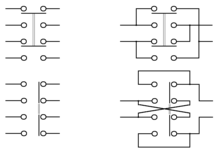Toggle switch
A toggle switch , changeover switch or changeover contact is a switch with three (sometimes four) connections that opens one circuit and closes another at the same time.
A changeover switch makes a contact in every position. The common center connection COM ( common ) is connected to NC ( normally closed ) in the rest position and to NO ( normally open ) in the other position . Thus, the center connection is connected to either one or the other contact.
If the third connection is not used, the switch can be used as a normal on / off switch .
Single pole changeover switch
The English abbreviation is SPDT “ S ingle P ole D ouble T hrow” and means “Single Pole double turning”.
He will u. a. used for changeover circuits, with which you can switch the light on at one end and off at the other in a hallway, for example. Further applications are 2-stage power or speed switch, signal path switch.
The function can be implemented by contact pieces that change their position either between three contacts or two contact pairs. In the case of slide and rotary switches, it depends on the design whether the opening contact will definitely open before the other closes ( break before make ) or whether there is a short time during the switchover during which both contacts are closed ( make before break ).
Two-pole changeover switch
The abbreviation is DPDT " D ouble P ole D ouble T HROW", meaning "double-pole double umlegend".
Internally, it consists of two toggle switches that are flipped simultaneously. This is done with a contact tongue, a rocker or a switching element that switches between three contacts or two independent contact pairs, accordingly in the first case it has two separate switching paths and six connections and in the last case 4 switching paths and 8 connections (see also the picture on the right and Picture above).
With the appropriate external wiring as in the picture on the right, it can act as a reversing switch to change the direction of rotation of motors. The two connections on the right and left are connected either straight or crossed on the other side. A cross switch is also built with this wiring .
- Circuit symbol for toggle switch
Series changeover switch
In house installation, for example, two changeover switches are called which are housed in a common housing and have a split (double) rocker switch. The designation series switch has historical reasons, a more obvious designation would be double changeover switch. While single switches are mainly sold as two-way switches today, series switches are only available as two-way switches at an extra charge.
Series changeover switches with a mechanical lock ("interlocking"), which prevents both switches from being switched in the same direction, are also called blind switches . They are used to operate motorized blinds, roller shutter motors or all other drives in which a change of direction is intended and the simultaneous operation of the drive in both directions would lead to a malfunction.
See also
literature
- Günter Springer: Expertise in electrical engineering. 18th edition, Verlag - Europa - Lehrmittel, Wuppertal, 1989, ISBN 3-8085-3018-9
- Ernst Hörnemann, Heinrich Hübscher: Electrical engineering specialist training in industrial electronics. 1st edition. Westermann Schulbuchverlag GmbH, Braunschweig, 1998, ISBN 3-14-221730-4




